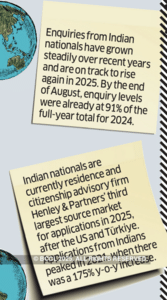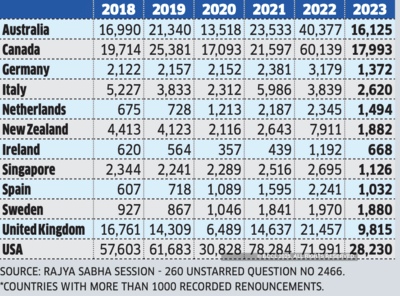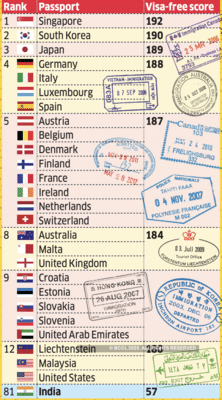As India ascends, many are choosing to stay or return home. Yet, a slice of HNIs are still chasing opportunities and alternate realities abroad, reports Kanika Saxena.
From billionaires hedging for mobility and tax, to professionals seeking career flexibility, to students mapping the PR-to-citizenship route, moving to another country for a foreign passport or even foreign residencies continue to lure high networth individuals (HNIs) in India. This, even as many countries are making the process tougher and more expensive.
Delving deep into the government’s migration data and from listening to on-ground voices of immigration advisors, wealth planners and lifestyle management firms, ET maps how citizenship abroad continues to be a strategic life plan for many Indians.
Where are folks going?
Top countries for which Indians renounced their citizenship in the past five years Indians are continuing to give up their passports, and the map of where they land is telling. Government data shows that the US, Canada, the UK and Australia remain the most popular destinations for naturalisation, followed by the Gulf states through special residency routes and smaller EU nations such as Italy and Portugal, which offer easier pathways to citizenship.


India doesn’t allow dual citizenship. One must surrender the Indian passport in order to accept citizenship elsewhere. The most common route remains naturalisation through residence, typically requiring five to 10 years of living in a country. For many Indians, the student-to-citizenship pipeline is popular: Higher education leading to work permits, then permanent residency and finally passports in places like Canada, Australia and the UK. Others pursue the Golden Visa track, where investment in real estate or funds in countries such as Portugal, Greece, Spain, Malta, or even the UAE’s long-term residency schemes, open doors to eventual naturalisation. At the fastest end of the spectrum lies direct citizenship-by-investment (CBI) programmes, particularly in the Caribbean — St Kitts & Nevis, Antigua, Dominica — or until recently, Malta.
The move itself may be triggered for multiple reasons:
1.Mobility: Visa-free or visa-on-arrival access to Schengen Europe, the UK and, in some cases, the US, shrinking travel friction.
2. Security: An insurance policy against political upheaval, policy shifts or climate risk and a safe fallback home.
3.Opportunities: Easier access to world-class education, employment, healthcare and welfare benefits.
4.Tax planning: While India taxes residents on global income, changing tax residence or domicile can optimise wealth and succession planning.
5.Family futures: Smoother student admissions, cross-border healthcare, inheritance and retirement planning.
On the Radar: Top residency programmes Indians are enquiring about in 2025
1. Australia National Innovation Visa
2. UAE Residence by Investment
3. Portugal Golden Residence Permit Program
4. Latvia Residence by Investment Program
5. US EB-5 Immigrant Investor Program
6. Austria Citizenship by Investment
7. Greece Golden Visa Program
8. Swiss Residence Program
9. Canada Start-Up Visa Program
10. New Zealand Active Investor Plus Visa Program
SOURCE: HENLEY & PARTNERS
Favoured Routes: Top options for HNIs to gain residency
GOLDEN VISA
●What it is: A residency permit in return for a qualifying investment (real estate, government bonds, business or approved funds).
●Usually permanent residency first, then citizenship after a long residence period (typically 5-10 years, sometimes longer).
CITIZENSHIP-BY-INVESTMENT (CBI)
●What it is: Direct citizenship (a passport) in exchange for a one-time donation or investment, without long residence or language tests.
●Immediate passport, with visa-free travel to 100-150+ countries depending on the nation.
How to Buy a Passport

The Passport Muscle
The Henley Passport Index 2025 ranks the world’s passports according to the number of destinations their holders can access without a prior visa.

Experts speak:
“Earlier the goal was to migrate permanently. Today, it’s about creating options. Most HNIs begin with long-term residencies — like the UAE’s Golden Visa or EU permits —gaining mobility, access to education and healthcare, and international wealth structuring flexibility. The drivers are tax planning, estate planning across borders and geopolitical hedging. Yet challenges remain. India does not allow dual citizenship, compliance under CRS and FATCA is unavoidable, and golden visa rules keep changing. The pragmatic approach is residency first, citizenship later, with careful tax and estate planning at every step.” — KAVITA BOTHRA, partner at Primassure LLP.
“Residency programmes, golden visas and entrepreneur visas have shifted from niche to mainstream in Indian HNI planning. Two segments stand out: Second residencies as lifestyle assets (Dubai, Singapore, the UK, the US, Portugal, Malta and Cyprus) and full relocations to Australia or Canada for education and career. Our role now spans cost-benefit analysis, investment-linked opportunities, safehaven planning and relocation logistics. Security and hedging rank highest, followed by mobility and business presence; education is key mainly for full moves. For wealthy Indian families, residencies are lifestyle assets as central as real estate or art portfolios.” — VIJAYA EASTWOOD, founder of CribLife.
From billionaires hedging for mobility and tax, to professionals seeking career flexibility, to students mapping the PR-to-citizenship route, moving to another country for a foreign passport or even foreign residencies continue to lure high networth individuals (HNIs) in India. This, even as many countries are making the process tougher and more expensive.
Delving deep into the government’s migration data and from listening to on-ground voices of immigration advisors, wealth planners and lifestyle management firms, ET maps how citizenship abroad continues to be a strategic life plan for many Indians.
Where are folks going?
Top countries for which Indians renounced their citizenship in the past five years Indians are continuing to give up their passports, and the map of where they land is telling. Government data shows that the US, Canada, the UK and Australia remain the most popular destinations for naturalisation, followed by the Gulf states through special residency routes and smaller EU nations such as Italy and Portugal, which offer easier pathways to citizenship.
India doesn’t allow dual citizenship. One must surrender the Indian passport in order to accept citizenship elsewhere. The most common route remains naturalisation through residence, typically requiring five to 10 years of living in a country. For many Indians, the student-to-citizenship pipeline is popular: Higher education leading to work permits, then permanent residency and finally passports in places like Canada, Australia and the UK. Others pursue the Golden Visa track, where investment in real estate or funds in countries such as Portugal, Greece, Spain, Malta, or even the UAE’s long-term residency schemes, open doors to eventual naturalisation. At the fastest end of the spectrum lies direct citizenship-by-investment (CBI) programmes, particularly in the Caribbean — St Kitts & Nevis, Antigua, Dominica — or until recently, Malta.
The move itself may be triggered for multiple reasons:
1.Mobility: Visa-free or visa-on-arrival access to Schengen Europe, the UK and, in some cases, the US, shrinking travel friction.
2. Security: An insurance policy against political upheaval, policy shifts or climate risk and a safe fallback home.
3.Opportunities: Easier access to world-class education, employment, healthcare and welfare benefits.
4.Tax planning: While India taxes residents on global income, changing tax residence or domicile can optimise wealth and succession planning.
5.Family futures: Smoother student admissions, cross-border healthcare, inheritance and retirement planning.
On the Radar: Top residency programmes Indians are enquiring about in 2025
1. Australia National Innovation Visa
2. UAE Residence by Investment
3. Portugal Golden Residence Permit Program
4. Latvia Residence by Investment Program
5. US EB-5 Immigrant Investor Program
6. Austria Citizenship by Investment
7. Greece Golden Visa Program
8. Swiss Residence Program
9. Canada Start-Up Visa Program
10. New Zealand Active Investor Plus Visa Program
SOURCE: HENLEY & PARTNERS
Favoured Routes: Top options for HNIs to gain residency
GOLDEN VISA
●What it is: A residency permit in return for a qualifying investment (real estate, government bonds, business or approved funds).
●Usually permanent residency first, then citizenship after a long residence period (typically 5-10 years, sometimes longer).
CITIZENSHIP-BY-INVESTMENT (CBI)
●What it is: Direct citizenship (a passport) in exchange for a one-time donation or investment, without long residence or language tests.
●Immediate passport, with visa-free travel to 100-150+ countries depending on the nation.
How to Buy a Passport

The Passport Muscle
The Henley Passport Index 2025 ranks the world’s passports according to the number of destinations their holders can access without a prior visa.
Experts speak:
“Earlier the goal was to migrate permanently. Today, it’s about creating options. Most HNIs begin with long-term residencies — like the UAE’s Golden Visa or EU permits —gaining mobility, access to education and healthcare, and international wealth structuring flexibility. The drivers are tax planning, estate planning across borders and geopolitical hedging. Yet challenges remain. India does not allow dual citizenship, compliance under CRS and FATCA is unavoidable, and golden visa rules keep changing. The pragmatic approach is residency first, citizenship later, with careful tax and estate planning at every step.” — KAVITA BOTHRA, partner at Primassure LLP.
“Residency programmes, golden visas and entrepreneur visas have shifted from niche to mainstream in Indian HNI planning. Two segments stand out: Second residencies as lifestyle assets (Dubai, Singapore, the UK, the US, Portugal, Malta and Cyprus) and full relocations to Australia or Canada for education and career. Our role now spans cost-benefit analysis, investment-linked opportunities, safehaven planning and relocation logistics. Security and hedging rank highest, followed by mobility and business presence; education is key mainly for full moves. For wealthy Indian families, residencies are lifestyle assets as central as real estate or art portfolios.” — VIJAYA EASTWOOD, founder of CribLife.
You may also like

Giorgi Mamardashvili goes from zero to hero as Liverpool star saves Spain penalty

UAE defeats Oman 2-1 in AFC World Cup qualifiers, tops group A; edges closer to 2026 FIFA World Cup

Dave Allen falls short on big stage as Arslanbek Makhmudov defeats Brit

Universal Credit claimants may lose money for missed calls without 'good reason'

Amanda Holden treated by doctors mid-radio show following incident at home






